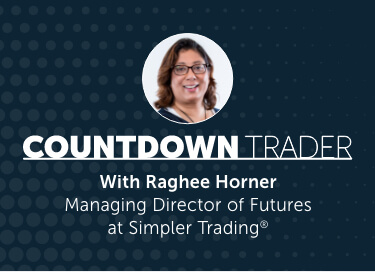The Guide to Naked Options: Part 2
Last week, we talked about naked options and why you shouldn’t be afraid of them. The real risk with the long calls or long puts is limited to whatever you paid for the option. Now, you may be asking yourself…
“What’s the big deal with trading naked options?”
The flip side of buying options is selling them but that’s where it gets a bit tricky. Your risk in going “short,” “collecting premium/credit,” and “selling” is different than buying options because your risk of loss can be undefined. The market is always moving and circumstances are changing which is great because it gives us opportunities to use different strategies to be successful in our trading.
Why would I short or collect credit on an option?
Countdown Fun Fact: The terminology is selling an option or shorting an option.
Remember that now you’re collecting premium and you’re actually betting against the option that you sold. Here’s a scenario…
The market overall is heading higher. There’s an uptrend, but recently there’s been a retracement (or a move) to the downside. Your analysis said it’s more likely that after the correction, the market will continue in the uptrend.
Selling Puts:
You may want to capitalize on that bearish momentum (movement lower) by selling puts. This simply means that other traders are interested in taking advantage of movement lower. In fact, these sellers are thinking that the market might keep moving lower, and they want to own a put or a directional bet on the market moving lower. Because you think the market will continue in an uptrend, you think your risk in selling puts is lower.
It may take a moment to conceptualize, but again, just keep this idea in mind. When you’re selling a call, you actually expect the market to go lower. When you’re selling a put, you actually should expect the market to go higher.
So once you have that put, you’re now anticipating the market to resume its uptrend. If it does, your put will lose value which is great because you have already collected in it. If you’re using the strategy of momentum, you’re collecting more premium than it’s actually worth. That’s how you profit. Now, let’s flip that around to the call side…
Selling Calls:
The markets are heading lower but all of a sudden they bounce, they rally, they might even rip higher. Into that move higher, traders are often frenzied to buy calls in anticipation of more highs to come.You then step in with your opinion that the market will resume its downtrend and you sell calls.
That means you collect premium on those calls.You’re selling calls because you believe, at a future date, whatever premium you collected will be greater than the original value. You feel that the markets are overall heading lower.
Now, we’ve covered how to sell, the momentum, and the psychology behind selling premium. You’re really thinking the market’s going to go the opposite way versus the thing that you’ve sold. Basically, you want that thing that you’ve sold to go lower in value, but how do you protect yourself?
Should you ever be uncovered (or naked) when you’re selling, collecting credit, or shorting an option? The answer is NO. Now, this is my opinion, but let me tell you why. Let’s talk about risk because that should always be the foundation to what we do as traders — calculate potential risk.
Let’s discuss risk…
When you have a naked option that you have sold short (collected credit) and the market’s moving lower, your risk is undefined. Your option is allowing someone to make a bullish bet on the market. Theoretically, the upside in any stock (or ETF or futures) contract is defined.
I don’t advocate naked options, but again, when you sell a put your risk is defined. This means the market can go to zero in stocks and in ETFs. Before you get too confident on that, let’s remember in 2020, crude oil went negative. All of a sudden the whole idea of selling naked puts really got shaken up.
You need a safety-net…
So how does the safety-net work? If you have executed selling a put in the market, ideally you can buy a put at a lower strike in case the put you sold starts to increase in value. This basically means that you’ve collected premium.
Now] that premium is worth more than you paid. In other words, you’re losing money on that premium that you sold. If you bought a put below the strike as the market heads lower, the put that you sold will gain in value, which is the opposite of what you want. However, the put that you bought is also gaining in value which would be your safety-net.
The market is sold off, and puts are going to be more valuable so we consider selling those. Again, we don’t want to sell a put without a safety-net. In this case, the market starts to sell off, but it’s still within the context of an intact uptrend.
In this case, I can’t do what I refer to as “legging in” but I can still look at selling that put. Therefore, I’ll buy a put below the strike of the put that I sold. If the market keeps going lower, I’m protected by this safety-net.
The put that I bought will increase in value while the put that I sold will increase in value. That’s not the scenario we want for a profitable trade, however, we have a safety-net.
Let’s flip this around to an uptrend…
Let’s say you’re looking at selling a call and it’s in an uptrend. The best way to think about selling calls in an uptrend is not as a directional bet, but rather as an offset in cost. So, before the top of your head blows up, let’s talk about what that position would be. It’s very commonly known as a call vertical and this is something that I like to do.
Let’s talk about the specific scenario:
If the market is heading higher and I want to get a long call, now I’m buying this call. I anticipate the market will continue after it’s retraced, however, let’s say that call is rather expensive.
Perhaps it’s a stock like Booking or Amazon… high price stuff. What’s considered high is going to vary from trader to trader. If you feel that the premium you have to pay to be long is a little bit on the upper end of your budget, you may want to offset that cost.
You can do so by selling an “out-of-the-money” call within the context of an uptrend. This is where you would use a call vertical. You took advantage of buying the call on a down day (or on a retracement) with the idea that the market’s going higher, but that call is rather expensive.
You’ll say, “well, I know that it will limit what I could make for this particular trade, but by selling an ‘out-of-the-money’ call, I can collect some credit and reduce the overall cost of this trade,” which is now two legs.
Let’s review — one long call, one short call, you bought the call, which is a debit then you’ve shorted an “out-of-the-money” call, which is your credit now. Is that naked? No, because if the market continues to go higher, your long call will gain in value.
Your short call will also gain in value, but again, you already own it’s offset by the long call. So that’s really what we’re talking about. This safety-net concept is how I’ve found a way to offset my risk if the market goes against the option that I’ve sold.
Said another way, if the call is on the higher end of our budget (or if we’d like to offset the cost or potential loss) our option would be to leg in. You could utilize a multi-leg option strategy. I’ll buy the calI and then sell an “out-of-the-money” call at a later date when the market moves up and there’s some decent premium to collect.
Put credit spread:
In the case of an uptrend, the other strategy that I’ll use is a put credit spread. In this case, we’re collecting premium preferably on a down-day in an uptrend. Keep in mind, I sold an option, so I have a call vertical or a put credit spread.
I sold a call, an “out-of-the-money” call… Remember that we first bought an “at-the-money” call and that call that I’ve sold is not okay/covered.
We don’t mind having naked LONG calls, but we do not want naked SHORT calls (or calls that we’ve sold without some sort of safety-net).These are some broad strokes, but that begins the conversation… How can we start to look at multi-leg strategies and then also consider selling an option? To learn more, join me in my Sector Secrets Mastery…See you there!



